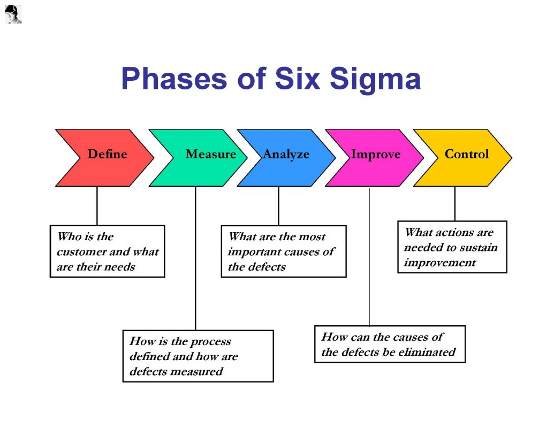It is a common misbelief that the quality-oriented, data-driven Six Sigma methodology is meant only for large organizations that rely heavily on production and service processes.
Given its hoary association with General Electric where it became synonymous with business improvement, and not just quality, the misconception is but natural. Its origin at Motorola, and adoption by big names like Ford Motor Company, Wipro, Maersk, Amazon and Boeing has proved its efficacy as a business strategy that enables organizations to increase their profits by optimizing their operations, improving quality and eliminating defects.
However, small and medium enterprises run scared, assuming that Six Sigma implementation would drain manpower and financial resources, adding to costs without fetching returns on investment.
In recent years, the focus on Big Data has also added to the confusion. Primarily because Six Sigma is considered a complex exercise involving mathematical and statistical calculations. Defined as a measure of process performance, Six Sigma enables organizations to limit defects to 3.4 per million opportunities, which in turn makes 99.99966% of its products or services error-free.
So what are the obstacles to Six Sigma implementation in small and medium organizations?
- Smaller businesses are overawed by the calculation-intensive process and forget to factor in the simple tools, techniques and solutions at hand, including Minitab, Pareto charts, Fishbone diagrams, Scatter diagrams and Control charts.
- The Japanese martial arts terms to denote expertise in ascending order –White Belt, Yellow Belt, Green Belt, Black Belt and Master Belt—confound the smaller companies aspiring to practice Six Sigma, as they think benefits will accrue only if maximum employees are Black Belts or that the entire “belt repertoire” should be represented in the organization.. The truth is only selected personnel need that level of training.
- With Agile methodologies coming in, no enterprise needs to be tied down to a single process or set of tools. Six Sigma can easily be complemented with a range of quality-linked methodologies like Lean, Total Quality Management, and ISO 9000.
How can these problems of mindset be addressed?
The secret lies in approaching Six Sigma as a “small data” project and in providing simple training to the staff through data quality workshops, on-the-job coaching and in-class assignments. Trainers, consultants and mentors play a crucial role in positioning the Six Sigma concept not so much as statistics but rather as ‘statistical thinking.”
What small companies should ensure is that the investment in training should pay off in terms of benefits of the Six Sigma implementation.
Data Literacy is the New Six Sigma
According to a 2018 study by Gartner, “Fostering Data Literacy and Information as a Second Language: A Gartner Trend Insight Report,” by 2020, 80 percent of organizations will initiate deliberate competency development in the field of data literacy, acknowledging their extreme deficiency.
Analyst Valerie A. Logan, Research Director, Gartner, says, data literacy is the new Six Sigma. “Almost 30 years ago, a major shift occurred when the notions of business process re-engineering and Six Sigma arrived…by the late 1990s, Six Sigma became part of the fabric of most Fortune 500 organizations…today, we stand on the threshold of another shift— data literacy. Just as workers in the 1990s had to work differently, the same is true now. No longer is organizational change defined entirely by the trinity of “people, process and technology”; there’s a new core element in town — “data,” and it changes everything.”
DMAIC or DMADV?
Data gathering for Six Sigma would begin with three simple questions in small organizations, often referred to as process performance metrics
- What is the purpose of the key process?
- What is the expected deliverable?
- How will the success of the project be measured?
Data literate managers can refine any process based on the answers to the above broad questions, no matter what the budget is to increase customer satisfaction and improve bottom lines.
Small and medium enterprises who implement Six Sigma should therefore know that Big Data is no longer the Holy Grail of Enterprise Quality Management Software solutions. The real value lies in Fast Data, Relevant Data, Actionable data, and Smart Data.
With this in mind, any small enterprise should first choose the right process methodology.
While the Define, Measure, Analyze, Improve and Control (DMAIC) method is better suited for improvement of processes that are already in use, the Define, Measure, Analyze, Design and Verify (DMADV) method is employed to redesign a problematic process and verify the same.
To put it differently, the two processes collect data, conduct a root cause analysis and apply the “intelligence” gathered differently:
- DMAIC minimizes variation in an existing process while DMADV aims to produce a first-time-right process.
- DMAIC is a corrective process while DMADV is preventive.
- DMAIC uses quantitative statistical tools while DMADV uses qualitative tools
- DMAIC focusses on critical to quality and critical to cost parameters, while DMADV focusses on customer wants and needs and so critical to process factors like design.
- DMAIC is a short-term project while DMADV is long-term.
Judging by the simple yet scientific approach to quality and business excellence through data adopted by Six Sigma, small organizations should choose the correct method to optimize use of the data collected. The wrong choice of methodology will not yield the desired results.
Focus on Effectiveness Too
The role of management in the small and medium enterprises embracing Six Sigma cannot be neglected. The psychology of small business entrepreneurs is to seek quick return on investments. So they often neglect the need to be effective, hand-in-hand with being efficient.
The paper Barriers for implementation of Six Sigma by Small and Medium Enterprises (Raghunath A and Dr. Jayathirtha R V, the International Journal of Advancements in Research & Technology, Volume 2, Issue2, February-2013) dwells on this at length: “Instead of finding out the cost associated with the current level of ineffectiveness, companies try to get short term cost benefit by concentrating on current level inefficiencies. As a result, organizations identify wrong process parameters for measurement like machine downtime rather than wrong tolerance on a critical dimension. Ultimately this leads to higher cost of production to reduce the number of defective parts which could have been solved relatively easily by redesign of the part with higher tolerance for that particular dimension. So, Six Sigma implementation should call for balance between improvement of efficiency and effectiveness of processes while aiming at reduction of cost and enhancement of customer satisfaction.”
This focus on the cause of ineffectiveness is very much a part of the Shewhart Cycle, put forth by Six Sigma proponent, Edward Demings who stressed the need to closely follow the manufacturing process and record data to correctly identify the reason for defects. To this day, companies who follow the Plan-Do-Study-Act cycle earn the Deming Prize. Check out the winners in 2019 here.








